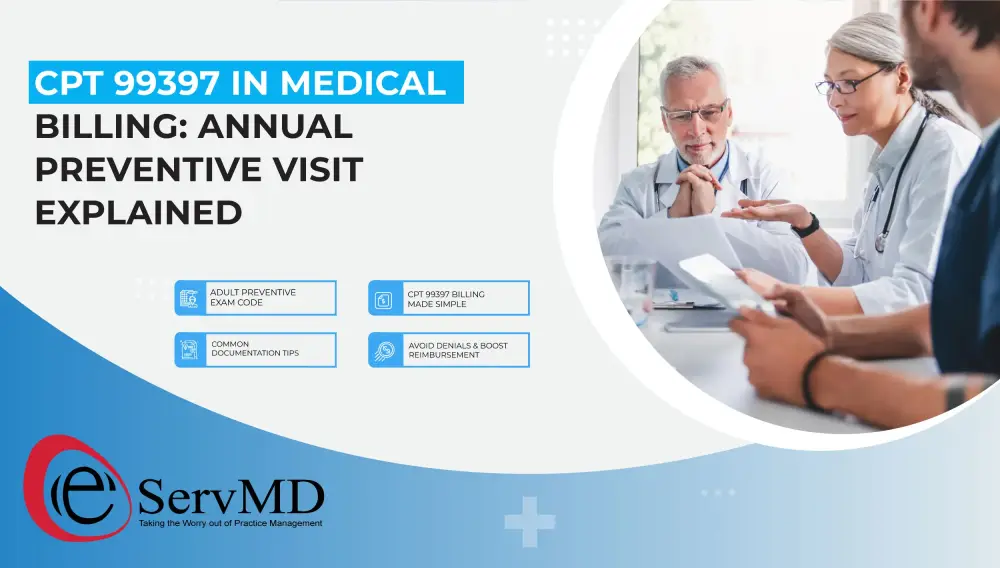
Preventive care isn’t just about patient wellness it’s also a critical part of every practice’s revenue stream. CPT 99397 in medical billing is the code used for annual preventive visits for established adult patients. Yet, many providers still struggle with correct usage, documentation, and payer compliance.
In this blog, we’ll break down what CPT 99397 is, how to bill it accurately, and share real-life insights from providers and billers who’ve mastered this code.
What is CPT 99397 in Medical Billing?
CPT 99397 represents a preventive medicine evaluation and management (E/M) service for an established patient aged 65 years or older.
It’s not a “problem-oriented” visit instead, it focuses on overall health assessment, risk evaluation, and preventive care discussions.
Definition (AMA CPT® 2025):
“A periodic, in-depth preventive health evaluation and management of an individual, incorporating an age and gender specific medical history, physical examination, personalized counseling, and evidence-based strategies for risk reduction.”
A billing specialist at eServMD shared how a provider’s routine annual wellness visit was initially billed as CPT 99214 instead of CPT 99397. The claim was denied because preventive and problem oriented codes follow different documentation and reimbursement rules. Once corrected, the claim was reimbursed quickly proving how vital code accuracy is for compliance and cash flow.
When to Use CPT 99397
You should use CPT 99397 when performing a preventive exam for an adult aged 65 or older who has been seen previously by your practice. This visit includes lifestyle counseling, screening discussions, and updates to immunizations or medication lists.
Documentation Requirements
To bill this code properly, documentation must include:
-
Comprehensive medical, surgical, and social history
-
Full physical examination appropriate for age
-
Counseling on risk factors, diet, and exercise
-
Preventive screenings based on age and gender
Tip: Make sure preventive details are documented separately from problem-based discussions. If a patient also discusses a specific condition, a modifier (e.g., 25) might apply for an additional E/M service.
For more help with correct documentation standards, check out our detailed post on CPT 99215 in Medical Billing: High-Level Office Visit Code.
CPT 99397 Reimbursement Guidelines
Reimbursement for CPT 99397 varies by payer but typically ranges from $120 to $180 depending on location and payer contract. Medicare does not cover CPT 99397 because it offers its own “Annual Wellness Visit (AWV)” codes (G0438, G0439).
However, many commercial payers reimburse this preventive code under adult preventive benefits.
Medicare & Private Payer Rules
-
Medicare: Does not pay for CPT 99397; instead, use AWV codes.
-
Commercial Payers: Often pay if the visit meets preventive criteria and the patient’s plan covers annual exams.
CPT 99397 vs 99396: What’s the Difference?
While both are preventive codes, CPT 99396 is used for established adults aged 40–64, whereas CPT 99397 applies to those 65 and older.
| Code | Patient Type | Age Group | Description |
|---|---|---|---|
| 99396 | Established | 40–64 years | Adult preventive exam |
| 99397 | Established | 65+ years | Senior preventive exam |
Common Mistake:
Many practices mistakenly bill 99396 for patients over 65, which leads to denials or payer audits.
If you’d like to learn how mid level codes differ, see our detailed guides on CPT 99214 and CPT 99213.
Best Practices for Accurate 99397 Billing
1. Use EHR Templates Wisely
Create structured templates for preventive visits, separating preventive and problem oriented documentation. This helps ensure compliance and reduces errors.
2. Conduct Internal Coding Audits
Perform quarterly internal audits (or partner with an RCM company like eServMD) to verify your preventive codes are used correctly.
3. Verify Payer Rules
Some payers require “wellness visit” terminology, while others need “preventive visit.” Cross check payer specific coding rules to avoid confusion.
4. Document Time Spent (if required)
Although time isn’t usually the deciding factor in preventive visits, tracking total encounter time helps support your claim if reviewed.
5. Train Staff Regularly
Billing staff should stay updated with CMS guidelines and payer policies. Many denials occur due to simple oversights in age criteria or documentation.
Why Preventive Coding Matters for Your Practice
Preventive codes like CPT 99397 do more than bring reimbursement they improve patient engagement and practice efficiency.
When billed correctly, these visits reduce administrative rework and help identify chronic conditions early.
Dr. Ayesha, an internal medicine physician, shared that her practice began coding preventive visits correctly in 2025. Within months, reimbursement accuracy improved by 18%, and patients appreciated the clarity in visit types. Their billing partner, eServMD, also noticed a 25% drop in rework on denied claims.
This shows how real collaboration between providers and billing teams can turn preventive coding into a profit-friendly process.
For more denial prevention strategies, see our blog on Denial Management in Medical Billing.
Make CPT 99397 Billing Easier
CPT 99397 in medical billing is an essential code for preventive care in established older adults. It ensures patients receive age appropriate screenings and that providers are fairly compensated.
The key to success lies in accurate documentation, payer verification, and awareness of Medicare limitations.
If you want your preventive billing to be error-free and more profitable, partner with experts who understand the nuances of medical coding and payer rules.
👉 Schedule a demo with eServMD today to optimize your preventive billing workflows and get paid faster every time.
FAQs — CPT 99397 in Medical Billing
Q1: What does CPT 99397 cover in medical billing?
A1: CPT 99397 covers an adult preventive exam for patients aged 65 and older, including routine check-ups and counseling services.
Q2: How often can CPT 99397 be billed?
A2: CPT 99397 can generally be billed once every 12 months for eligible patients, depending on payer policies.
Q3: What’s the difference between CPT 99397 and 99396?
A3: CPT 99397 is used for established patients aged 65+, while 99396 applies to adults aged 40–64 for preventive exams.
Q4: How to avoid claim denials for CPT 99397?
A4: Ensure proper documentation of preventive services, accurate patient age, and payer-specific frequency limits.
